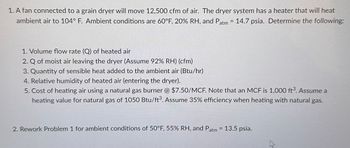
College Physics
11th Edition
ISBN: 9781305952300
Author: Raymond A. Serway, Chris Vuille
Publisher: Cengage Learning
expand_more
expand_more
format_list_bulleted
Concept explainers
Question

Transcribed Image Text:1. A fan connected to a grain dryer will move 12,500 cfm of air. The dryer system has a heater that will heat
ambient air to 104° F. Ambient conditions are 60°F, 20% RH, and Patm = 14.7 psia. Determine the following:
1. Volume flow rate (Q) of heated air
2. Q of moist air leaving the dryer (Assume 92% RH) (cfm)
3. Quantity of sensible heat added to the ambient air (Btu/hr)
4. Relative humidity of heated air (entering the dryer).
5. Cost of heating air using a natural gas burner @ $7.50/MCF. Note that an MCF is 1,000 ft³. Assume a
heating value for natural gas of 1050 Btu/ft³. Assume 35% efficiency when heating with natural gas.
2. Rework Problem 1 for ambient conditions of 50°F, 55% RH, and Patm = 13.5 psia.
27
Expert Solution
This question has been solved!
Explore an expertly crafted, step-by-step solution for a thorough understanding of key concepts.
Step by stepSolved in 3 steps with 1 images

Knowledge Booster
Learn more about
Need a deep-dive on the concept behind this application? Look no further. Learn more about this topic, physics and related others by exploring similar questions and additional content below.Similar questions
- 2. A vertical Cylinder with a heavy piston contains air at 300 K. The initial pressure is 3.35*10^5 Pa, and the initial volume is 0.300 m^3. Take the molar mass air as 28.9 g/mol and assume Cv = 5R/2, R = 8.314 J/mol K a) Find the specific heat of air at constant volume in units of J/kg C b) Calculate the mass of the air in the cylinder c)Suppose the piston is held fixed. Find the energy input required to raise the temperature of the air to 691K.arrow_forward4. An ideal gas is contained in a vessel of volume 12 L (12 liters) at a temperature of 20 °C and a pressure of 9 atm. a) How many moles of gas are in the vessel? b) How many molecules of gas are in the vessel?arrow_forward1. Two moles of helium gas are placed in a cylindrical container with a piston. The gas is at room temperature 27 °C and under a pressure of 3.3.105 Pa. When the pressure from the outside is decreased, while keeping the temperature the same as the room temperature, the volume of the gas doubles. Use that the gas constant R = 8.31 J/(mol K). Think: What kind of process is this? Isobaric, isothermal, adiabatic, isochoric or non-quasi-static? (a) Find the work the external agent does on the gas in the process. W = ext. agent (b) Find the heat exchanged by the gas and indicate whether the gas takes in or gives up heat. Assume ideal gas behavior. Q= ✓J Q is realeased by gas Q is absorbed by the gasarrow_forward
- I need the answer as soon as possiblearrow_forward1. Most automobiles have a coolant reservoir to catch radiator fluid that may overflow when the engine is hot. A radiator is made of copper and is filled to its 17 -L capacity when at 10 °C. What volume of radiator fluid will overflow when the radiator and fluid reach their 95 °C operating temperature, given that the fluid's volume coefficient of expansion is ß= 400 ×10-6/°C? Note that this coefficient is approximate, because most car radiators have operating temperatures of greater than 95 °C. The volume coefficient of expansion of copper is 5.1 x 10-5/°C. Hint: Consider the expansions of both the fluid and the radiator. AV: Larrow_forward
arrow_back_ios
arrow_forward_ios
Recommended textbooks for you
 College PhysicsPhysicsISBN:9781305952300Author:Raymond A. Serway, Chris VuillePublisher:Cengage Learning
College PhysicsPhysicsISBN:9781305952300Author:Raymond A. Serway, Chris VuillePublisher:Cengage Learning University Physics (14th Edition)PhysicsISBN:9780133969290Author:Hugh D. Young, Roger A. FreedmanPublisher:PEARSON
University Physics (14th Edition)PhysicsISBN:9780133969290Author:Hugh D. Young, Roger A. FreedmanPublisher:PEARSON Introduction To Quantum MechanicsPhysicsISBN:9781107189638Author:Griffiths, David J., Schroeter, Darrell F.Publisher:Cambridge University Press
Introduction To Quantum MechanicsPhysicsISBN:9781107189638Author:Griffiths, David J., Schroeter, Darrell F.Publisher:Cambridge University Press Physics for Scientists and EngineersPhysicsISBN:9781337553278Author:Raymond A. Serway, John W. JewettPublisher:Cengage Learning
Physics for Scientists and EngineersPhysicsISBN:9781337553278Author:Raymond A. Serway, John W. JewettPublisher:Cengage Learning Lecture- Tutorials for Introductory AstronomyPhysicsISBN:9780321820464Author:Edward E. Prather, Tim P. Slater, Jeff P. Adams, Gina BrissendenPublisher:Addison-Wesley
Lecture- Tutorials for Introductory AstronomyPhysicsISBN:9780321820464Author:Edward E. Prather, Tim P. Slater, Jeff P. Adams, Gina BrissendenPublisher:Addison-Wesley College Physics: A Strategic Approach (4th Editio...PhysicsISBN:9780134609034Author:Randall D. Knight (Professor Emeritus), Brian Jones, Stuart FieldPublisher:PEARSON
College Physics: A Strategic Approach (4th Editio...PhysicsISBN:9780134609034Author:Randall D. Knight (Professor Emeritus), Brian Jones, Stuart FieldPublisher:PEARSON

College Physics
Physics
ISBN:9781305952300
Author:Raymond A. Serway, Chris Vuille
Publisher:Cengage Learning

University Physics (14th Edition)
Physics
ISBN:9780133969290
Author:Hugh D. Young, Roger A. Freedman
Publisher:PEARSON

Introduction To Quantum Mechanics
Physics
ISBN:9781107189638
Author:Griffiths, David J., Schroeter, Darrell F.
Publisher:Cambridge University Press

Physics for Scientists and Engineers
Physics
ISBN:9781337553278
Author:Raymond A. Serway, John W. Jewett
Publisher:Cengage Learning

Lecture- Tutorials for Introductory Astronomy
Physics
ISBN:9780321820464
Author:Edward E. Prather, Tim P. Slater, Jeff P. Adams, Gina Brissenden
Publisher:Addison-Wesley

College Physics: A Strategic Approach (4th Editio...
Physics
ISBN:9780134609034
Author:Randall D. Knight (Professor Emeritus), Brian Jones, Stuart Field
Publisher:PEARSON